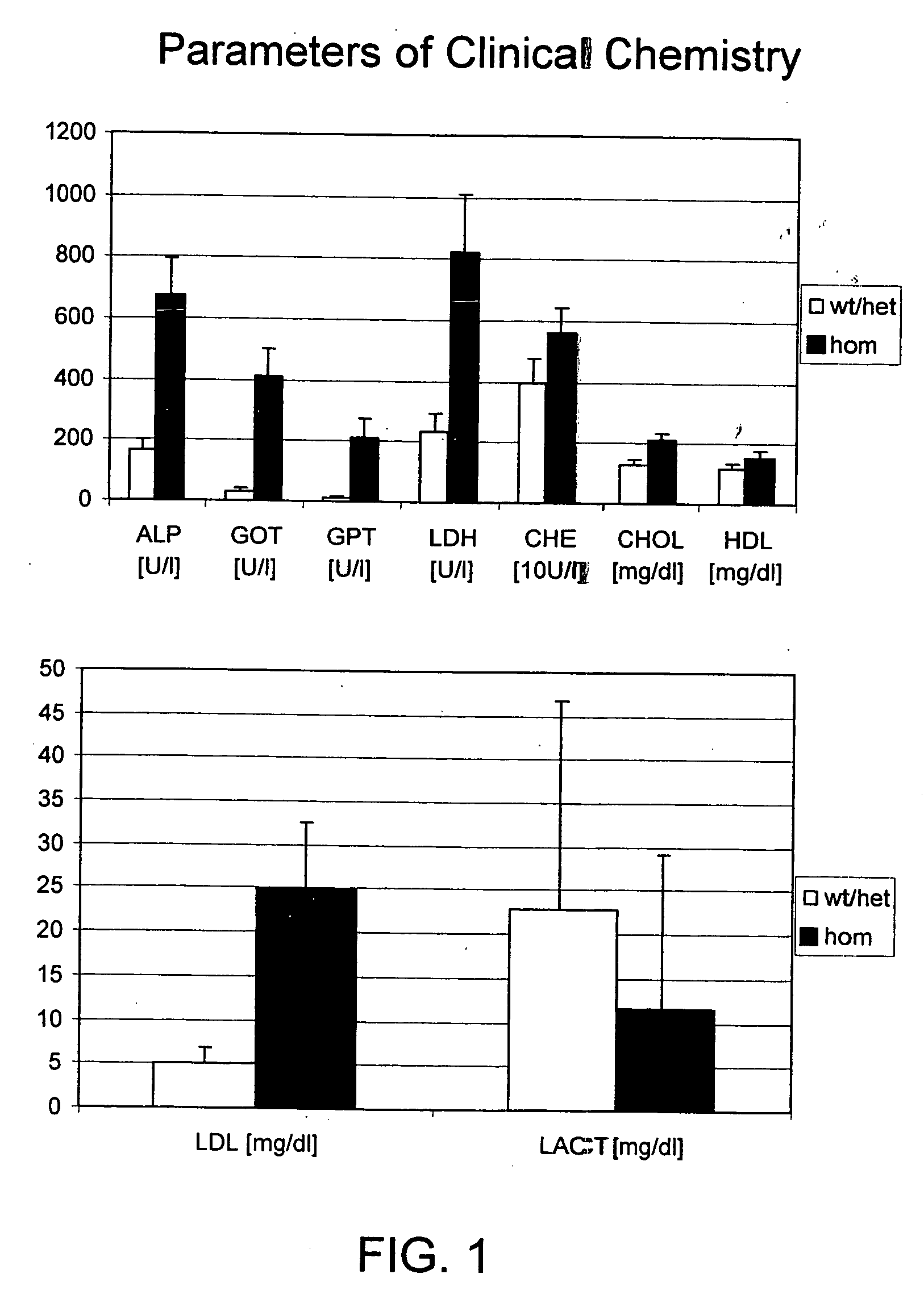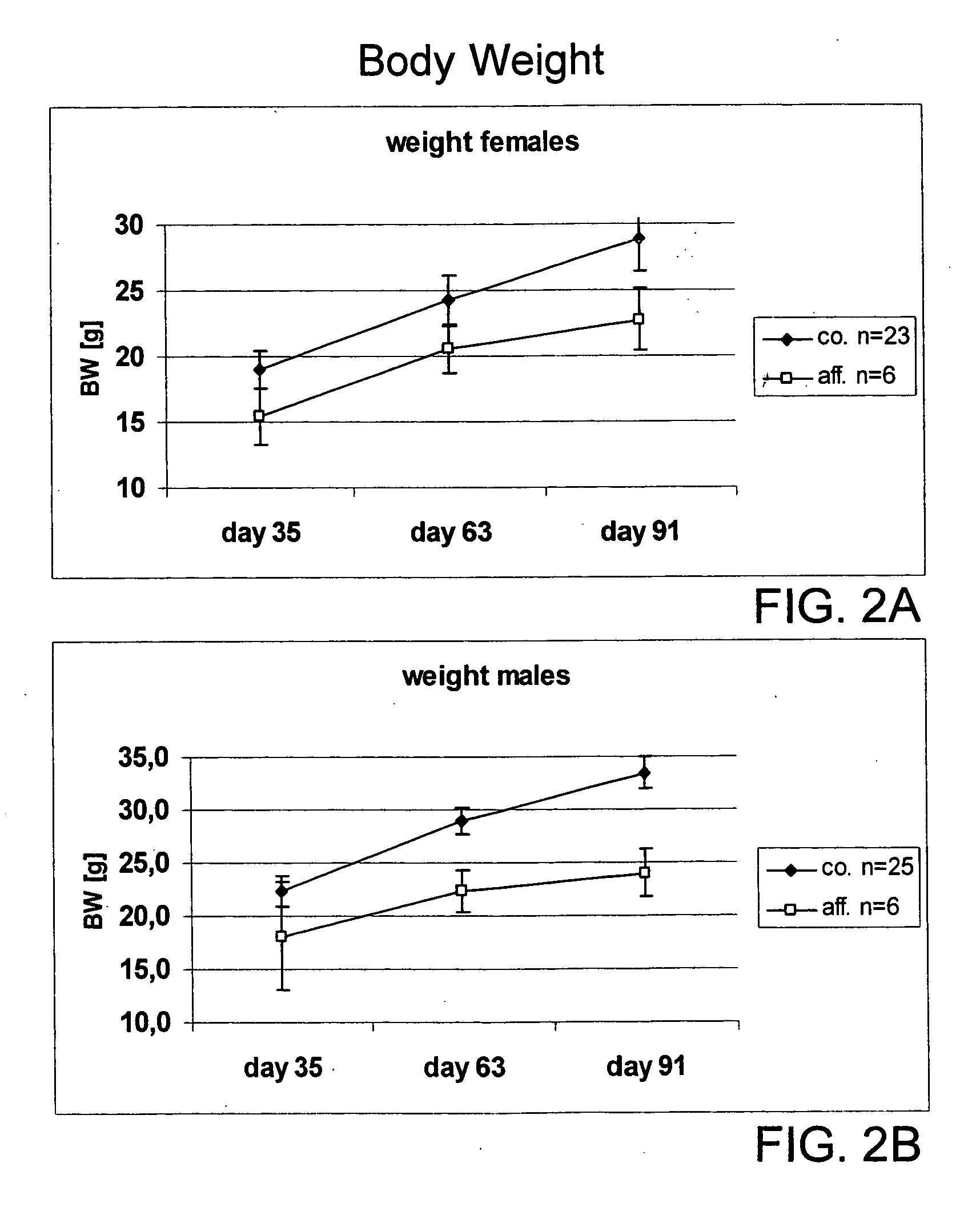Spinster-like protein genes, expression products, non-human animal model: uses in human metabolic disorders
a spinster-like protein and gene technology, applied in the field of non-human vertebrate animal models with an alteration, can solve the problems of increased secondary disease burden, increased risk of cardiovascular or gastrointestinal side effects,
- Summary
- Abstract
- Description
- Claims
- Application Information
AI Technical Summary
Benefits of technology
Problems solved by technology
Method used
Image
Examples
example 1
ENU (Ethyl-nitroso-urea) Treatment to Produce Mutagenized Animals
[0331] To produce mutants, C3HeB / FeJ male mice (The Jackson Laboratory, Bar Harbor Me., U.S.) were injected intraperitoneally three times (weekly intervals between 8-10 weeks of age) with ethyl-nitroso-urea (ENU) (Serva Electrophoresis GmbH, Heidelberg, Germany) at a dosage of 90 mg / kg body weight The injected male mice were regularly mated to wild type C3HeB / FeJ female partners fifty days after the last injection. The resultant F1 progeny (up to 100 offspring) were then analyzed for dominant phenotypes.
[0332] Generation of F3 Progeny
[0333] F3 progeny were generated as described below. All breeding partners were older than 8 weeks (56 days); preferably females were between 8-12 weeks old and males were between 8-16 weeks old.
[0334] Production of F1-animals (db1)
[0335] Each ENU-male produced as described above was used to generate more than 30 male and 30 female pups, which were interbred as described below.
[0336]...
example 2
Physiological Characteristics of the Mutant Animals
[0339] For blood analysis animals were starved over night. Animals were anaesthetized by ether. 500-600 μl blood per animal was taken retro-orbitally by a heparinized capillary and collected in heparin tubes. Blood plasma was separated by centrifugation. The following sixteen plasma parameters were measured with a Hitachi 912 using the recommended reagents according to the manufacturers instructions (Roche Diagnostics, Mannheim, Germany): calcium, creatinine, phosphate, glutamic-oxaloacetic tsaminase (GOT), glutamate pyruvate transaminase (GPT), lactate dehydrogenase (LDH), cholinesterase (CHE), triglycerides, glucose, total protein, urea, alkaline phosphatase (ALP), cholesterol (CHOL), high density lipoprotein (HDL), Low density Lipoprotein (LDL) and lactate (LACT). Values are considered to be abnormal if they are beyond the 99 or 1 percentile, respectively.
[0340] The clinical chemistry of animals homozygous for the Spinl1 mutati...
example 3
Necroscopy and Histology of the Mutant Animals
[0347] Macroscopic examination of sacrificed animals corroborated the pDEXA findings. Subcutaneous, intraperitoneal and gonadal fat was virtually absent.
[0348] Fixation, processing and staining was performed according to histological standard procedures.
[0349] Microscopic examinations of the kidneys revealed the absence of intracellular fat vacuoles (arrows in FIG. 4A, haematoxylin & eosin stains of 5 μm paraffin sections). No further abnormalities were observed in the kidney histology. The perirenal fat pad contained white adipose tissue with interspersed islets of brown adipose tissue (arrowheads in FIG. 4b). The white adipocytes were reduced in size compared to wild type (arrows in FIG. 4b). This points to a reduced fat storage with otherwise undisturbed cellular function.
[0350] Histological examination of liver tissue revealed most conspicuous microscopical changes. Wild type (wt) animal liver sections, stained with haematoxylin ...
PUM
| Property | Measurement | Unit |
|---|---|---|
| Temperature | aaaaa | aaaaa |
| Temperature | aaaaa | aaaaa |
| Fraction | aaaaa | aaaaa |
Abstract
Description
Claims
Application Information
 Login to View More
Login to View More - R&D
- Intellectual Property
- Life Sciences
- Materials
- Tech Scout
- Unparalleled Data Quality
- Higher Quality Content
- 60% Fewer Hallucinations
Browse by: Latest US Patents, China's latest patents, Technical Efficacy Thesaurus, Application Domain, Technology Topic, Popular Technical Reports.
© 2025 PatSnap. All rights reserved.Legal|Privacy policy|Modern Slavery Act Transparency Statement|Sitemap|About US| Contact US: help@patsnap.com



